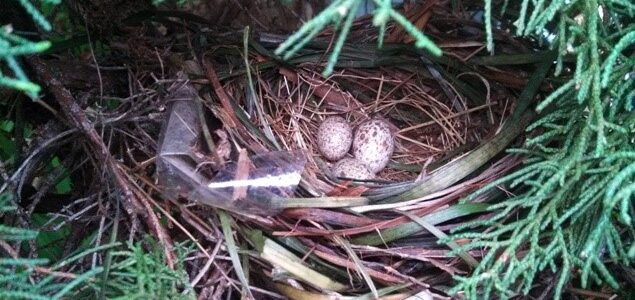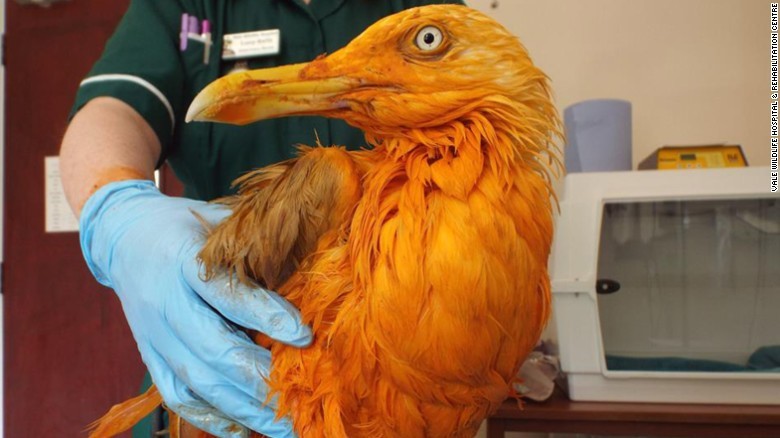
Part 12 – Summary and Conclusion
In our last eleven segments we covered 19 human-related causes of wild bird mortality (by-catch, domestic cats, collision mortality, methane gas burners, oil spills, pesticides, power lines, wind farms, trash, acid rain, oil and wastewater pits, horseshoe crab harvesting, disease, invasive species, renewable energy, coal mining, lead poisoning, hunting, and wildlife trafficking).
By-catch is the discarded catch of any living marine resource plus retained incidental catch and unobserved mortality due to a direct encounter with fishing gear. You can help by supporting sustainable fishing practices. Everything you need to know can be found here.
Domestic cats are now the greatest direct human-related cause of wild bird mortality. We see evidence of this in our facility, but here is the science to substantiate this finding. Even well-fed cats will hunt. What can you do? Keep pet cats indoors. Leash train kitty or build or buy a catio. Do not feed feral cats or support practices that sustain them in the wild.

Collision mortality includes death from airplanes, trains, and cars, as well as communication towers, power lines, wind turbines, and window and building strikes. There are a variety of things you can do to lessen the chance a bird flies into your window. You can use window treatments or place decals onto your windows two inches apart horizontally and 4 inches apart vertically. You can also use window films or bug screens. If you feed birds, make sure feeders are placed within 3 feet of a window or more than 30 feet from a window.
The threat of methane gas burners is not a new phenomenon, but wildlife rehabilitators have recently become more cognizant of the issue as casualties arrive at centers. Raptors are burned when they land on or fly over burners installed to flare off the methane that accumulates inside of sanitary landfills. This happens at landfills because these sites serve as excellent hunting grounds for birds of prey. You can help by checking local landfills. Find out if birds have been burned there. Make landfill operators and the Department of Natural Resources or similar entity responsible for wildlife aware of this issue. There are some practical solutions that will serve to minimize impact. This information is from Save Our Seabirds, located in Sarasota, Florida.
An oil spill can be a catastrophic event that plagues our natural resources for decades after the spill occurs. An especially large or hard to contain spill can exact a heavy toll on numerous species of seabirds and waterfowl and marine life. Oil spills from vessels are serious hazards that can claim many lives in a short period of time; however, other sources of oil including jet skis, motorboats and run-off from streets into storm drains also kill wild birds. Read tips here for how you can help prevent oil pollution.
Pesticides are chemicals designed to kill target organisms deemed to be pests, but pesticides also kill non–targeted wild animals, including birds. Avoid the use of pesticides in and around the home. Learn more at Beyond Pesticides. Buy bird friendly coffee and organic food whenever possible.
Eagles and other raptors can die from power line electrocutions and direct collisions into power lines. Wind farms are yet one more hazard in the skies. Wind energy production affects birds primarily through direct mortality from collisions into the turbine blades, towers, power lines, or other related structures. Individuals can help by reducing consumption of electricity, thus requiring fewer alternative fuel sources. We must keep in mind that wind energy is not ‘green’ unless bird-smart principles are utilized.
Trash, especially marine debris, kills birds through ingestion and entanglement. This is happening across beaches, on waterways, and presumably in residential areas and landfills. Fishing line, cigarette butts, balloons, plastic bags and plastic beverage bottles all take a toll when not disposed of properly. The following mantra is ancient, but worth repeating. Reduce, reuse, and recycle.
Acid rain happens naturally through emissions from volcanoes. However, the principal cause of acid rain is sulfur and nitrogen compounds from human sources, such as electricity generation, factories, and motor vehicles. Coal power plants are one of the most polluting. Individuals can help prevent acid rain by conserving energy and driving less. Learn more here.
Oil and wastewater pits may kill up to one million birds per year according to the U.S. Fish and Wildlife Service. Birds are attracted to the oily ponds mistaking them for wetlands. Closed containment systems or netted oil pits that exclude birds would solve this problem.
One anthropogenic cause of bird mortality that is highly species–specific is horseshoe crab harvesting. This activity is directly related to the mortality of red knots (Calidris canutus). An estimated 90 percent of the red knot subspecies C. c. rufa utilizes the Delaware Bay along the Atlantic flyway as a stopover to refuel on the eggs of spawning horseshoe crabs as these shorebirds journey to the Arctic breeding grounds each spring. You can help save overturned or stranded horseshoe crabs through this volunteer effort.
If you feed birds you need to take precautions to minimize the risk of diseases spreading among the visitors to your feeders and water sources. Diseases such as trichomoniasis, aspergillosis, and salmonellosis are easily transmitted at birdfeeders and birdbaths. Click here for tips from the National Audubon Society concerning feeder maintenance and hygiene.
Invasive species are those that spread uncontrollably after being introduced to an area where they are not native. Invasive animals and plants are major threats to native bird species in numerous ways. Nonnative predators kill adult birds as well as eggs and young. Introduced birds such as European Starlings can displace native birds such as woodpeckers, swallows, and bluebirds from nesting sites. Invasive plants can render habitat unsuitable. You can help by planting native trees and shrubs. Do you know the importance of pollinators? Learn more here.
Alternative energy is any form of energy that does not come from fossil fuels. Some of these are renewable, meaning they are generated from natural resources, including sunlight, wind, and rain. That sounds like a wonderful solution to decrease our dependence on coal, natural gas, and oil while avoiding the resultant air and water pollution, environmental degradation, and global warming. The reality is that there are serious environmental consequences from wind turbines, solar farms, and hydroelectric power. Learn more here.
Coal mining can degrade land and some mining practices have impacted a variety of songbirds through deforestation. Help by reducing your carbon footprint. Calculate your carbon footprint by going here.
According to the Center for Biological Diversity, animals that scavenge on carcasses shot and contaminated with lead bullet fragments, or wading birds that ingest spent lead-shot pellets or lost fishing weights mistaking them for food or grit, can die a painful death from lead poisoning, while others suffer for years from its debilitating effects. Throughout the country, hunters are encouraged to use non-lead ammo such as copper. For a video showing the benefits of using copper bullets see here.
Hunting may be described as a wildlife management tool, a sustainable method of acquiring food, and for some, a tradition or sport. Hunting can be a contentious issue. Regardless of your position (and whether or not you hunt), we encourage folks to consider purchasing a Federal Migratory Bird Hunting and Conservation Stamp (also known as a Duck Stamp). These stamps are a vital tool for wetland conservation.
Wildlife trafficking is a multi-billion dollar industry and now the world’s fourth largest criminal market after drugs, weapons, and human trafficking. What can you do to help? Do not share videos on facebook that show wildlife handled in ways that blur the distinction between pet and wild animal. Learn about the natural history of a species and observe those animals in their native habitat.
We hope that this information has instilled a deep appreciation for wild birds and we encourage you to help protect them. You can read the 2016 State of the Birds report by going here. In conclusion, we share this quote by Edward Everett Hale… I am only one, but I am one. I can’t do everything, but I can do something.
Thank you for your support.
– Linda Cherkassky
